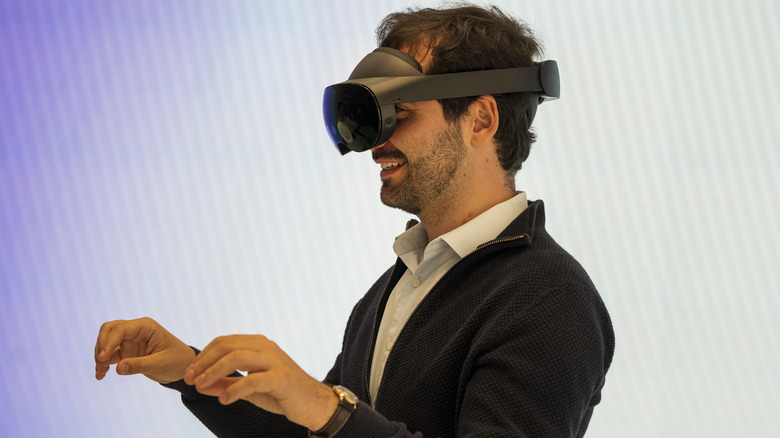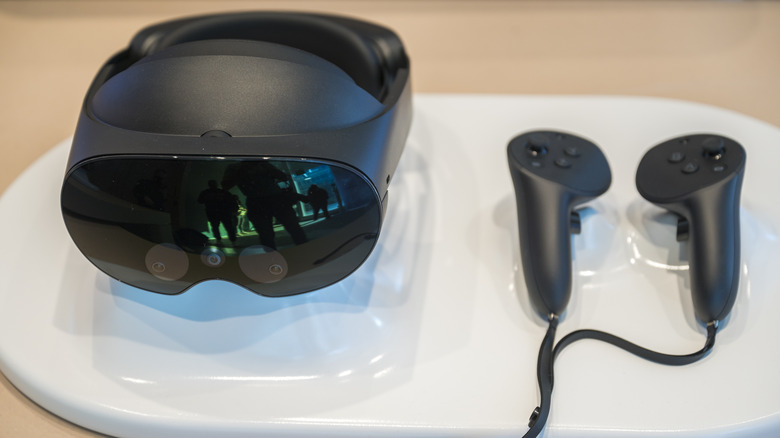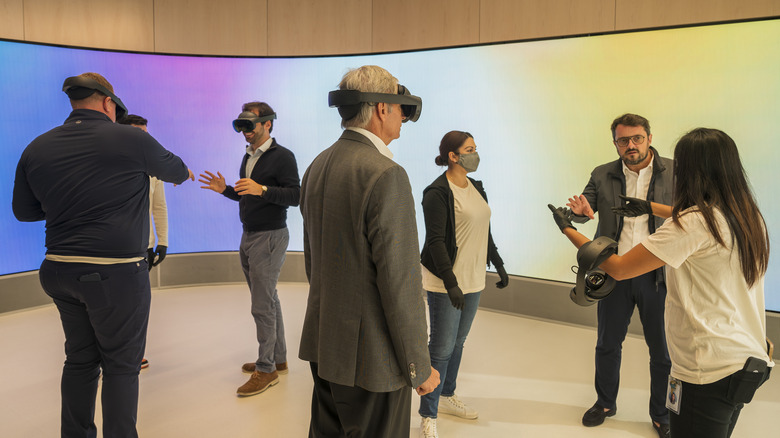Things You Won't Believe The New Meta Quest Pro Can Do
The metaverse is the next big thing, according to Facebook founder Mark Zuckerberg. In 2021, he rebranded Facebook into Meta, along with WhatsApp and Instagram. Before then, Facebook acquired Oculus for $2 billion in 2014. The plan was (and still is) for Oculus to design virtual reality and augmented reality headsets that would be used to access the metaverse. Four years after Facebook bought Oculus, it released its first stand-alone VR headset — the Oculus Go. Meta, formerly known as Facebook, also released the Oculus Quest and Rift S in 2019 for the same price.
However, Facebook discontinued the Oculus Go and Oculus Rift S in 2020 to focus on the Quest lineup. The company went on to release the Oculus Quest 2 the same year it shelved the Oculus Go and Oculus Rift S. But it wasn't done yet, Meta introduced its best VR headset yet, the Quest Pro, in 2022. Unlike previous VR headsets that were sold at $399 or less, the Quest Pro is a flagship VR headset that starts at $1,499.99. Why is it more expensive? Well, it all comes down to what it can do.
The Quest Pro gives you a natural facial expression
The Meta Quest Pro is designed with interior cameras that capture your natural facial expression and eye movement — this is a feature that is not available in the Oculus Quest 2. In other words, your avatar in the metaverse can mimic all of your facial expressions and eye movements in the real world to capture your emotions — if you're sad, happy, angry, anxious, or neutral. It's so accurate that if you were playing poker in the metaverse, your opponent could (or could not) read your facial expression.
However, natural facial expressions and eye tracking are disabled by default. If you want to activate the feature, you can head out to "Settings" and choose "Movement tracking." Next, you can opt for "Natural Facial Expressions" and "Eye tracking" options to capture your emotions in the metaverse. What's more, if you want to temporarily turn off the feature, you can use the shortcut in "Quick Settings."
Since privacy is a concern, users can prevent specific apps from accessing their natural facial expressions and eye movements. Oculus also assures its customers that "images your Meta Quest Pro captures of your eyes and face never leave your device and are deleted after processing."
The Meta Quest Pro can be used to improve productivity and creativity
The Passthrough is not a new feature on the Meta Quest Pro — you can also use it on the Oculus Quest 2 to see your real-world surroundings while you're still in the metaverse. But unlike the Quest 2, which features a black and white background, the Meta Quest Pro takes it to the next level by introducing a full-color Passthrough. This means that you could use an app like Immersed to project multiple virtual screens in the metaverse from your laptop in full-color mode, as demonstrated by Marques Brownlee.
Since the Meta Quest Pro makes it possible for computer-generated content to interact with physical objects in your space, it also doubles as an augmented reality headset for creativity. Meta says that if you want the best full-color Passthrough, your room should be bright enough for you to read a book while you're wearing the headset. However, according to CNET, it's still difficult to read text on your smartphone or smartwatch while you're wearing the headset.
The controllers don't lose connection
The Meta Quest Pro controllers don't have the loop design that is featured on the Oculus Quest 2. Instead, each Meta Quest Pro controller is designed with three cameras to track your body movement without relying on the headset. This means that the controllers don't lose connection when you're in the metaverse, even if you put them behind your back.
Besides that, each of the Meta Quest Pro controllers comes with Qualcomm Snapdragon 662 processor that is often used on smartphones. According to Meta, the Meta Quest Pro controllers feature TruTouch haptics that offer more advanced "trigger and thumb responses." You can also draw or paint in the metaverse using your controller's stylus tip.
Another big surprise is that the controllers don't use AA batteries like Oculus Quest 2 controllers. You can charge them concurrently with the headset using the charging dock. However, the new controllers are not exclusive to the Meta Quest Pro, and you can purchase them separately if you want to upgrade your Oculus Quest 2 controllers.
The Meta Quest Pro is more immersive with better performance
The Meta Quest Pro is 50% more powerful than the Oculus Quest 2. This is because it's fitted with Qualcomm's Snapdragon XR2+ — an upgraded version of the chip used in the Quest 2. Another improvement over the Quest 2 is the RAM — the Quest Pro is designed with 12 GB RAM, while the Quest is half of that capacity. Beyond that, the headset is only available with 256 GB internal memory, and a bigger 5,000 mAh battery.
But it's not just the performance specs that Meta upgraded; the Quest Pro is built with "new pancake lenses" that are 40% thinner than the previous model. "The LCD displays have 37% more pixels than Quest 2, and thanks to our new local dimming technology, 75% more contrast with richer and more vibrant colors that just make VR even more engaging," Mark Zuckerberg told us what to expect at the unveiling event. On top of that, the Quest Pro features magnetic light blockers so you can feel more immersed in the metaverse.
If you have $1,500 to spare, the Meta Quest Pro is an upgrade to the Quest 2, especially if you want to improve your work productivity and creativity in the metaverse. But if you want something better than the Quest 2, but you think the Quest Pro is too expensive, the Meta Quest 3 is coming in 2023 — and it could be sold for less than $500.




